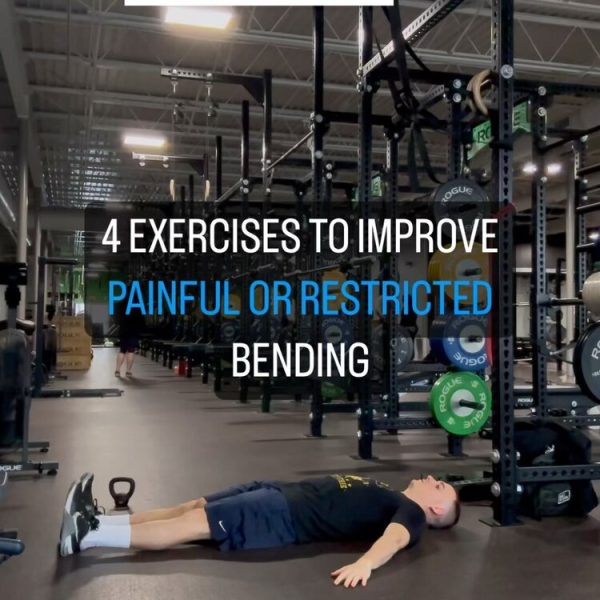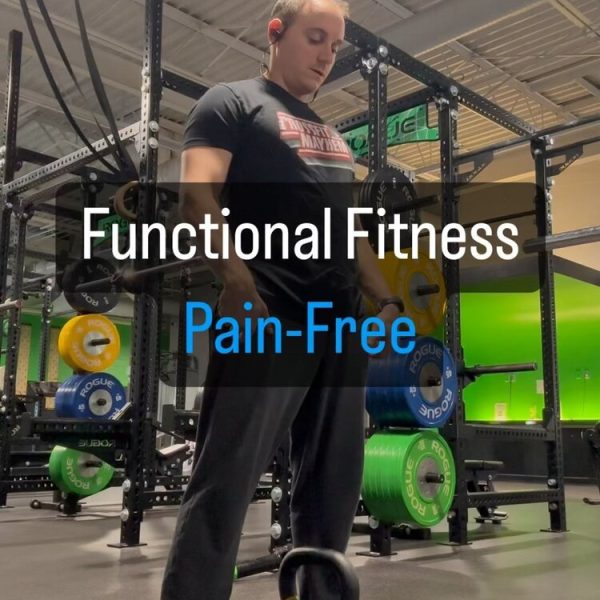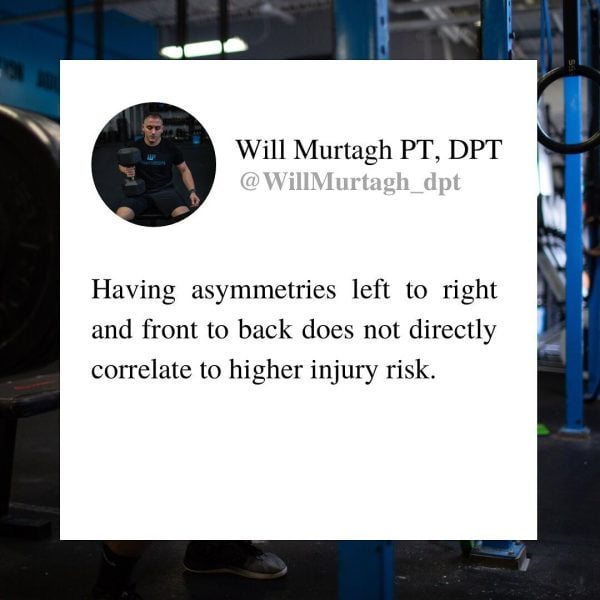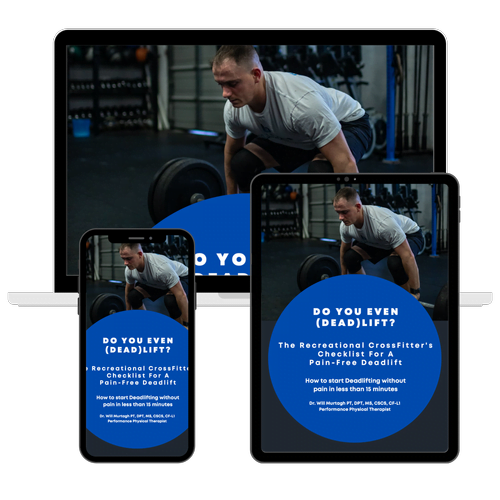Dr. Will Murtagh is a performance physical therapist and writer who helps Fitness Athletes elevate their fitness and train pain-free.
Lower back pain after deadlifts flat-out sucks. Even as a Physical Therapist, I have experienced how debilitating it can be and how much it gets in the way of training and your fitness goals. The Deadlift is one of the best exercises you can do, but it can also be a frequent trigger for lower back pain when done poorly.
Fortunately, lower back pain when deadlifting is fixable. Today, I will show you the five cues I have used to fix my back pain when deadlifting and how they help my 1:1 Pain-free Performance Program clients do the same.
Remember: this post is for informational purposes only and may not be the best fit for you and your personal situation. It shall not be construed as medical advice. The information and education provided here is not intended or implied to supplement or replace professional medical treatment, advice, and/or diagnosis. Always check with your own physician or medical professional before trying or implementing any information read here.

The Fitness Athlete’s Checklist For A Pain-Free Deadlift
What You’ll Learn Inside This Free Guide
- Uncover how you can Deadlift pain-free without wasting time on time consuming rehab or warm-ups.
- Learn which muscles need to be engaged just prior to performing the lift and how to do so.
- Understand why rest is not always the answer.
- Avoid common mistakes in core bracing to prevent future injuries.
- How to know if your training is actually the problem.
How To Prevent Lower Back Pain After Deadlifts:
Achieve Pre-Requisites & Progression
The best way to ensure a pain-free Deadlift and prevent low back pain is to assess your readiness and choose appropriate weights or scaling options based on your capabilities and available range of motion. Many back injuries occur when individuals push themselves too hard or lift excessively heavy weights during Deadlifts.
A prerequisite for the Deadlift is the ability to comfortably touch your toes with feet together and knees fully extended. If you lack the necessary flexibility and mobility, lifting weights from the floor can lead to compensations, misalignment, and excessive strain on the lower back. While occasional instances may not cause harm, consistently performing Deadlifts with bad form over years of training can lead to pain.
You have a few options if you cannot comfortably touch your toes. You can elevate the barbell using boxes or plates to achieve the same starting position. Or, you can begin with Romanian Deadlifts, which start from the top down and still train the hinge pattern. As you progress, focus on gradually increasing repetitions and loads.
Start with higher repetition ranges (12-15 reps) to build motor control and optimal movement patterns. This progressive approach can help you train optimally and prevent excessive lower back soreness.
Brace Your Core
Insufficient trunk stiffness is a common cause of lower back issues, especially when heavy lifting is involved. Creating stiffness in the core is vital to protect the spine from flexing or extending under load and to optimize Deadlift performance. Flexing or extending the spine under load can eventually lead to injuries like herniated discs or Spondylolisthesis.
Proper bracing is critical to preventing these movements, even with heavy loads. When bracing for the Deadlift, high intrabdominal pressure is generated by using the breath and engaging various trunk muscles, including the Diaphragm, Rectus Abdominis, Obliques, Transverse Abdominis, and Multifidus.
Inhaling through the diaphragm and then contracting the trunk muscles against a closed glottis creates stiffness throughout the trunk that cannot be overcome by the bar’s weight, ensuring the spine remains in a safe, neutral position.
A helpful analogy is visualizing a full can of soda. With liquid (inhaled air) inside the can, it can withstand weight placed on top without deforming. Conversely, without liquid (exhaled air), even a lesser weight can crush the can.
To brace and stabilize for the Deadlift, place your tongue on the roof of your mouth, inhale through the nose to activate the diaphragm, and expand the belly. Once you have achieved a full inhale, contract the core muscles without allowing air to escape. This sensation of stiffness indicates proper bracing.
Engage Your Lat Muscles
It’s crucial to generate significant tension in the lower back to maintain a stable spine while performing a heavy deadlift. In addition to proper bracing, another effective strategy is to engage the Latissimus Dorsi muscles, commonly known as “The Lats.” These large muscles on the body’s backside originate from various points on the trunk and attach to the upper arms. You can feel them working when you perform rowing exercises like lat pull-downs or Cable Column Rows.
The lats also create tension in the lower back by pulling on the Thoracolumbar Fascia, a dense connective tissue in that region. When the lat muscles are activated, they help restrict movement in the lower back while lifting heavy loads.
To engage the Lats during the Deadlift:
- Start by gripping the barbell with your Deadlift stance and grip width.
- Pull up slightly on the bar to eliminate any slack, ensuring the barbell is secure within the collars.
- As you lower your hips into the pulling position, keep the bar close to your shins while simultaneously pulling your shoulder blades back and down toward your back pockets.
Additionally, squeeze your triceps against the sides of your torso to “close the armpit.” These actions effectively engage the Latissimus Dorsi muscles and create tension in the Thoracolumbar Fascia, helping to protect your lower back during the Deadlift.
Keep The Barbell Over The Midfoot
The next cue for a pain-free Deadlift introduces some basic physics principles into the equation. While it may not be the most exciting topic during intense training sessions, applying these principles is crucial for long-term, pain-free Deadlifting.
You’ve probably heard the cue to “keep the bar close” or give your shins a “haircut” with the bar when setting up for a heavy Deadlift. This cue is beneficial as it helps engage your Latissimus Dorsi muscles and positions the bar favorably for lifting. However, applying this cue is essential to avoid potential issues.
Keeping the bar close to your shins should happen once the bar is over the mid-foot. Suppose the bar is initially over the tongue of your shoe. In that case, your torso may become overly parallel to the floor, and your shoulders might extend too far past the bar. On the other hand, if you set up with the barbell too far away from your shins or beyond your toes, you create a larger momentary arm between your hips and the barbell.
Both scenarios lead to situations where your lower back and trunk must work harder than necessary, increasing the likelihood of instability in stabilizing the spine effectively. To set up properly for the Deadlift, aim to position the barbell directly over the mid-foot. Start with your shoulders directly over the barbell or slightly in front of it, and maintain a slight torso angle based on your limb lengths. These guidelines prevent excessive moment arms and help avoid pain and injury during Deadlifts.
The Hips And Shoulders Should Rise Together
The final cue in Deadlifting addresses a compensation or movement fault that may occur during the lift itself. Unlike the previous cues performed before lifting the weight, this cue aims to correct an ongoing issue.
When starting to lift the bar off the ground, there is a tendency for the hips to rise faster than the shoulders, resembling a Romanian Deadlift rather than a conventional Deadlift. Several factors can contribute to this. One possibility is the need to learn how to drive the chest up and maintain an equal rate of rise between the shoulders and hips.
Another factor is a lack of leg strength compared to lower back strength. If your lower back is naturally stronger than your legs, you may rely on it excessively during Deadlifts.
As mentioned earlier, the lower back muscles are designed for a specific amount of work compared to the muscles of the legs, such as the Glutes and Hamstrings. When the hips rise faster than the shoulders, the load on the lower back muscles increases, and the lumbar spine may begin to extend to facilitate the transition from a bent-over position to an upright position.
Additionally, a faster hip rise leads to significantly higher forward sheer forces on the lower back, increasing the risk of injury or pain due to overuse.
This does not imply that exercises like the Romanian Deadlift are bad; they are excellent for strengthening the posterior chain. However, in conventional Deadlifts, where the loads are typically higher, it is best to distribute them evenly over the legs, hips, and lower back to protect the lumbar spine.
By maintaining a more vertical chest position and ensuring that the shoulders and hips rise at an equal rate, you can better control these sheer forces, reducing the risk of pain and injury during Deadlifts.
Causes of Lower Back Pain
Low back pain can come from various sources. Several structures of the lower back can be affected, and different types of back injury can occur. These include injury to the back muscles, including the Erector Spinae, Multifidus, and Quadratus Lumborum, which would be a lower back strain.
Spinal disc pathology can include issues like herniated discs or disc degeneration. These discs act as the spine’s shock absorbers. They cushion the forces of gravity or, in the case of someone who trains, the forces acting on the body from things like Deadlifts and other weight-training exercises. Discs can cause lower back pain when they become herniated and begin to compress the nerves that protrude from the spinal cord or degenerate to allow for bone-on-bone contact.
Injury to the Facet Joints, which are small joints in the lower back that connect each spinal vertebrae, can also cause pain. The Facet joints allow for spine movement and can assist in providing stability when needed.
Facet joints can be involved in lower back pain when they become inflamed due to arthritis or the ligaments around them are sprained when proper form is not adhered to during a heavy exercise. Sprains of ligaments in the lower back can also occur with various other ligaments, such as the Iliolumbar ligament.
Lastly, the bones can be a source of injury with excessive weight or poor form of Deadlifting. When the good form is not adhered to, forces on the spine’s bones can exceed their ability to withstand them and ultimately lead to things like fractures or, over time, misalignments such as Spondylolisthesis.
These low back injuries may jump off the page. Still, they are simply classifications of what can cause low back pain during exercises like Deadlifts.
But the irony around low back injuries is that the Deadlift is a great exercise and can be the single most important exercise you can do to prevent these low back injuries from happening and build muscle strength in your entire posterior chain to avoid things like disc bulges, muscle spasm, and excessive low back soreness the next day.
Proper Deadlift Form
The term proper form gets a lot of attention when performing Deadlifts. The best way I have experienced as a Physical Therapist to illustrate what proper form looks like in the Deadlift is to reference what I learned in my CrossFit Level 1 certification course. These are deemed the “points of performance” for the conventional Deadlift.
Deadlift Points of Performance
- Maintain the spine in a neutral position.
- Keep your weight in the midfoot to the heels.
- Shoulders remain slightly in front of the bar in the set-up position.
- The barbell should remain in contact with the legs at all times.
- The hips and shoulders rise at the same rate the entire lift.
- The hips are completely open at the top of the movement, and the shoulders are behind the barbell.
If you follow these points of performance, you can be confident that your Deadlift form is spot on and your injury risk and performance will improve.
Types of Deadlifts
The Deadlift groups a specific exercise bundle that trains the Hinge movement pattern. The hinge pattern primarily focuses on using the posterior chain muscles, including muscles surrounding the upper back, lower back, hip joints, and knee joints. The spine muscle group includes the Erector Spinae, Multifidus, and Quadratus Lumborum. The hip extension muscle group consists of the Glute muscles, such as the Gluteus Maximus, Gluteus Medius, Gluteus Minimus, and Hamstrings.
But there is more than one way to perform the Deadlift. There are many different ways to accomplish the movement within a training program. It is ideal to incorporate many different kinds of Deadlifts over a year to continue providing training variation to the posterior chain and drive long-term improvements.
My Favorite variations of the Deadlift include:
These variations of the Deadlift all provide subtle variations to the exercise, allowing for different aspects of the lower body and posterior chain. Outside of giving variation in your training program, no variation is better or worse but better for your specific needs.
For example, suppose you are recovering from a back injury such as a herniated disc. In that case, you may opt for a Sumo Deadlift over a Romanian Deadlift since the anterior or forward sheering forces are less because of the position of the upper body during the movement.
Another example might be that you choose Conventional Deadlifts over Trap Bar Deadlifts because if you compete in CrossFit, the other variations are not tested, and thus, spending too much time on them may be counterproductive.
When deciding which type of Deadlift to do, consider what you need in your training program based on your previous injury history and current weaknesses or imbalances. Once you know those, you can select the best options to provide variety in your workouts and exclude the ones that exacerbate your lower back pain despite the steps I explain below!
These are the exact cues that I provide my clients inside of my 1:1 Pain-Free Performance Program, where I help fitness athletes eliminate lower back pain in under 12 weeks without missing time in the gym to rest so that they can stay fit and return to training pain-free.
Lower Back Anatomy
Lumbar Vertebrae
The lumbar vertebrae consist of five weight-bearing segments labeled L1 to L5 and are between the thoracic vertebrae and the sacrum; these vertebrae bear most of the body’s weight and are essential for maintaining proper posture. Intervertebral discs sit between each lumbar vertebra and act as shock absorbers.
But can also be a source of intense lower back pain when they herniate into the spinal column. These vertebrae are vital in distributing forces during movements such as deadlifting and squatting. Maintaining a solid and stable lumbar vertebra contributes to overall spinal health.
Sacrum
The sacrum is a triangular-shaped bone situated at the base of the spine, forming the back part of the pelvic girdle. Comprising five fused vertebrae (S1 to S5), the sacrum connects the spine to the hip bones on either side, enhancing stability in the pelvic region. It plays a crucial role in supporting the upper body’s weight and transferring it to the pelvic girdle. The sacrum also houses the sacral foramina, which allows for the passage of nerves and blood vessels. The sacrum forms the sacroiliac joint with the innomnant to complete the pelvis.
The Erector Spinae
The Erector Spinae muscles are a group of three parallel muscle bundles running along the spine’s length and are the main spinal extensor muscles. Comprising the iliocostalis, longissimus, and spinalis muscles, the Erector Spinae plays a crucial role in maintaining an upright standing position and controlling the movement of the vertebral column.
These muscles are responsible for the extension, lateral flexion, and rotation of the spine, providing essential support for daily activities and dynamic movements. During deadlift exercises, the Erector Spinae muscles contract isometrically to stabilize the spine and maintain a flat back.
This prevents excessive flexion or extension and ensures proper alignment during the hip hinge. Developing strength and endurance in the Erector Spinae is fundamental for overall spinal health, contributing to posture and the success and safety of various strength training exercises.
The Multifidus
The multifidus muscle is a deep muscle consisting of a series of short, triangular muscles that span each vertebra’s spinous process. Positioned along the spine, the multifidus is responsible for crucial roles in spinal stability and movement. Unlike some larger back muscles, the multifidus operates close to the spine, playing a vital role in segmental control and providing intricate support for individual vertebrae. This muscle is particularly essential for maintaining proper spinal alignment during various movements.
When engaged, the multifidus helps prevent excessive rotation and lateral flexion, contributing to overall spinal integrity. During compound movements like deadlifts, the multifidus stabilizes the spine, working with other back muscles to ensure proper form and minimize the risk of injury. Strengthening the multifidus is pivotal for supporting the spine, enhancing functional movements, and promoting a resilient lower back.
The Quadratus Lumborum
The quadratus lumborum muscle, situated deep within the lower back region, is a powerful yet often overlooked player in the complex orchestra of back muscles. This quadrilateral-shaped muscle connects the pelvis to the spine and the lowest rib, playing a crucial role in various movements and providing structural support.
Acting bilaterally, the quadratus lumborum helps in lateral flexion of the spine and contributes to maintaining an upright posture. It also assists in stabilizing the spine during movements like bending and twisting. Unilateral contraction of the quadratus lumborum tilts the pelvis. It helps elevate one side, enabling movements such as hiking one’s hip.
The quadratus lumborum provides stability to the lower back during activities like deadlifts, working synergistically with other muscles to ensure proper biomechanics. Understanding its importance is integral for enhancing core strength, preventing lower back discomfort, and optimizing overall movement patterns in daily activities and exercise routines.
My Experience With Lower Back Injury
My training has had its highs and lows – and sometimes some severe setbacks. As I’ve written in some of my past articles, I’ve had quite a few rough experiences with my lower back over the last few years. I had been following an intense Olympic lifting program, pushing my limits, and setting new deadlift PRs every week as each Friday was “wax out day.”
Then, one afternoon, it was like a lightning bolt hit me. When I stood up from a heavy deadlift, I felt a shooting pain down the right side of my back, and that was it! I was down for four days with a complete inability to stand.
Eventually, I could stand, and from there, I got right back into the gym with a focus on rebuilding my movement patterns to avoid ever having to go through this again. I overhauled my joint mobility and lumbar stability and incorporated the cues I mentioned above. Had it not completely unfolded the way it did, for better or worse, I wouldn’t be where I am today.
Injuring my lower back and bouncing back pushed me towards rehab as a physical therapist. As well as creating my 1:1 Pain-Free Performance Program, where I help clients rebuild their movement patterns to overcome lower-back injuries and return to training.
With these cues and relevant information on lower back injuries and the lower back muscles, you can better understand how you can incorporate the Deadlift into your training. Using the performance points above will help you avoid incorrect form and optimize your Deadlift sessions.
The Deadlift is an excellent exercise if your training goals include building strength. It is also a great way to keep your lower back healthy and avoid lower back injuries outside of the gym. Regardless of how you deadlift, whether conventional, sumo, or Romanian, everyone can benefit from some hinging. So pick which one is best for you and get training!
If you would like professional help from a Performance Physical Therapist without missing the gym to, visit a Physical Therapy clinic. In that case, I encourage you to book a free consultation HERE so we can understand why your back hurts, fix it, and prevent future injuries. Then you can get back to training hard and moving heavier weights!













